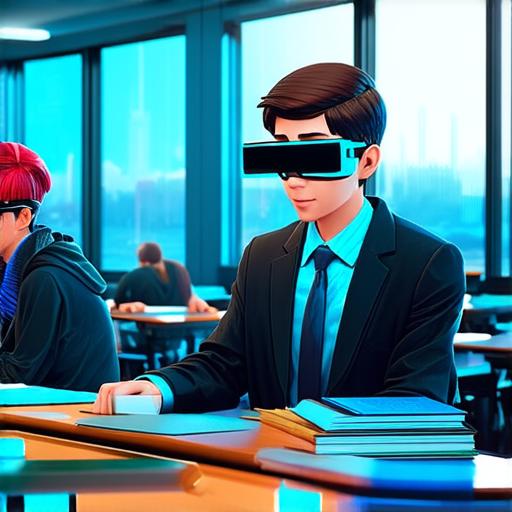Introduction:
Augmented reality (AR) is an exciting and rapidly-evolving technology that allows us to overlay digital content onto the real world. In recent years, AR has become more prevalent in our daily lives, with countless applications across various industries.
What is Augmented Reality?
AR refers to the technology that superimposes digital content onto the real world in real-time. This can be achieved using smartphones, tablets, or specialized devices such as AR glasses or headsets. The goal of AR is to enhance and enrich our experiences with the physical environment by providing additional context, information, and interactive elements.
Potential Applications of Augmented Reality:

AR has a wide range of potential applications across various industries, including:
-
Healthcare: In healthcare, AR can be used to improve medical procedures, enhance patient experiences, and provide remote assistance to surgeons. For example, the Vuforia platform is being used in the field of surgery to overlay digital markers onto the surgical site, allowing for precise and accurate placement of implants.
-
Education: AR has the potential to revolutionize the way we learn by providing interactive and immersive experiences. It can be used to create virtual labs, museums, and historical sites, allowing students to explore and interact with concepts in a more engaging way. The Google Expeditions app is an excellent example of this, as it allows users to take virtual tours of over 900 museums, landmarks, and other cultural institutions around the world.
-
Retail: AR can be used to enhance the shopping experience by providing product information, personalized recommendations, and interactive displays. IKEA’s AR app is an excellent example of this, as it allows users to visualize furniture in their homes before purchasing it.
-
Manufacturing: AR can be used to improve assembly processes, reduce errors, and enhance worker productivity. For example, GE Aviation uses AR to overlay digital instructions onto aircraft components, allowing technicians to perform maintenance more efficiently.
-
Advertising: AR can be used to create engaging and interactive advertisements that capture the attention of consumers. For example, Coca-Cola’s “Share a Coke” campaign used AR to allow users to personalize Coke bottles with their names, which was then shared on social media.
Developing Augmented Reality Experiences:
Developing an AR experience can be challenging, but there are several tools and frameworks available to help you get started. Some popular AR development platforms include:
-
Unity 3D
-
ARKit
-
Vuforia
-
Wikitude
Creating an effective AR experience involves several key considerations, including:
-
User Experience: The user experience should be intuitive, easy to navigate, and provide value to the user. This means considering factors such as the layout of the interface, the use of animations and visual effects, and the level of interaction required from the user.
-
Performance: AR experiences can be resource-intensive, so it’s important to optimize performance to ensure a smooth and seamless experience for the user. This involves minimizing load times, reducing the amount of data transmitted over the network, and ensuring that the app runs smoothly on a range of devices.
-
Content Creation: Creating engaging and compelling content is crucial to the success of an AR experience. This involves designing intuitive interfaces, creating visually appealing graphics and animations, and incorporating relevant information and context into the experience.
-
Testing and Iteration: Testing and iteration are essential for ensuring that an AR experience is effective and meets the needs of users. This involves testing the app on a range of devices, gathering user feedback, and making necessary changes to improve the overall user experience.
Conclusion:
Augmented reality is a rapidly-evolving technology with countless potential applications across various industries. As a developer, it’s essential to understand how AR works, its potential uses, and how to develop AR experiences for your users. With the right tools, frameworks, and considerations, you can create engaging and immersive experiences that enhance and enrich our interactions with the physical world.
FAQ:
1. What is the difference between augmented reality and virtual reality?
Augmented reality superimposes digital content onto the real world in real-time, while virtual reality creates a completely artificial environment for the user to interact with.
2. What are some common uses of augmented reality in healthcare?
AR has been used in surgery to overlay digital markers onto the surgical site, allowing for precise and accurate placement of implants. It can also be used to provide remote assistance to surgeons and enhance patient experiences by providing additional context and information.
3. What are some common uses of augmented reality in education?
AR has the potential to revolutionize the way we learn by providing interactive and immersive experiences. It can be used to create virtual labs, museums, and historical sites, allowing students to explore and interact with concepts in a more engaging way.
4. What are some common uses of augmented reality in retail?
AR can be used to enhance the shopping experience by providing product information, personalized recommendations, and interactive displays. For example, IKEA’s AR app allows users to visualize furniture in their homes before purchasing it.
5. What tools and frameworks are available for developing augmented reality experiences?
Some popular AR development platforms include Unity 3D, ARKit, Vuforia, and Wikitude. These platforms provide a range of tools and features for creating engaging and interactive AR experiences on iOS and Android devices, as well as AR glasses and headsets.
